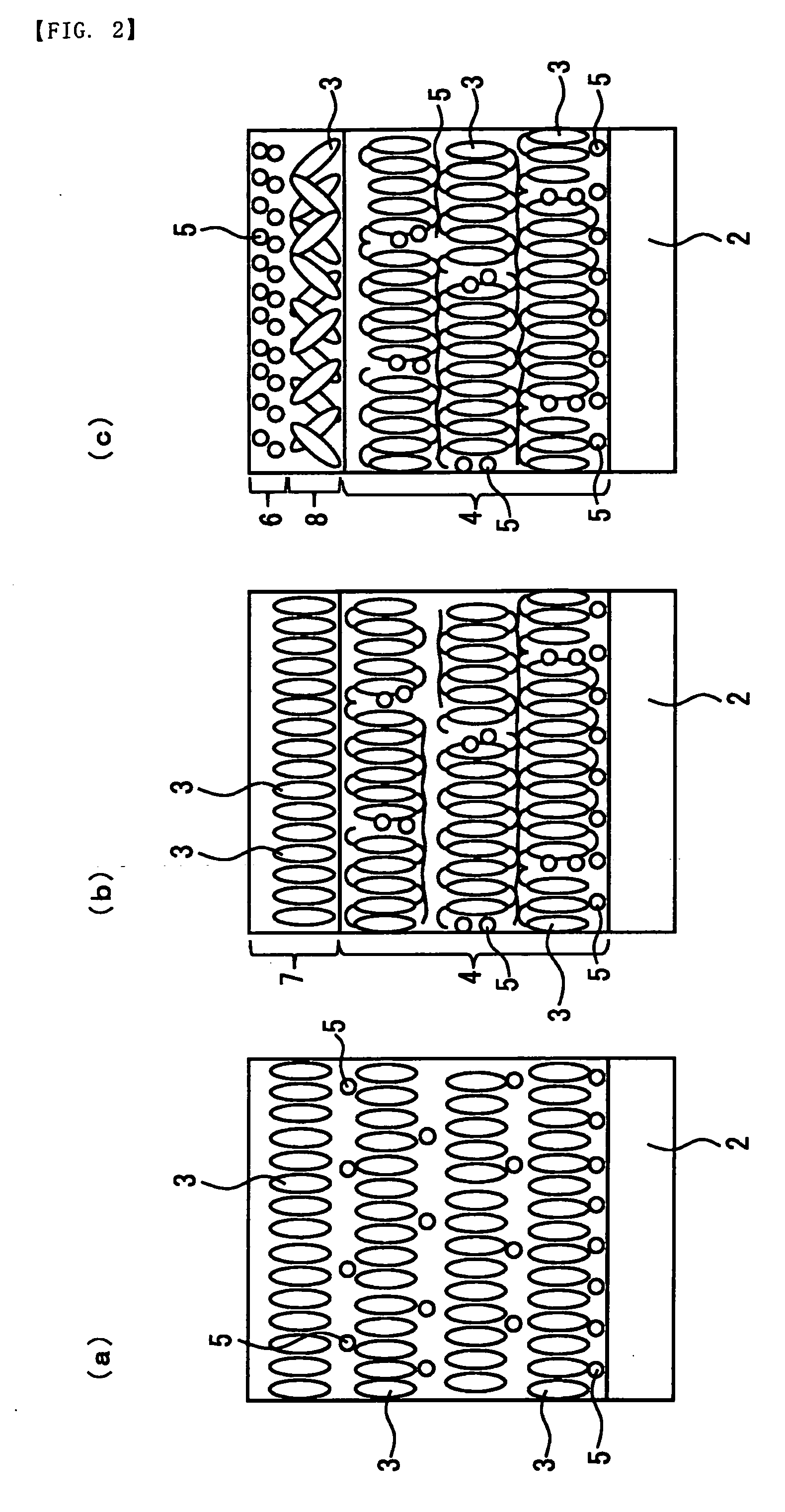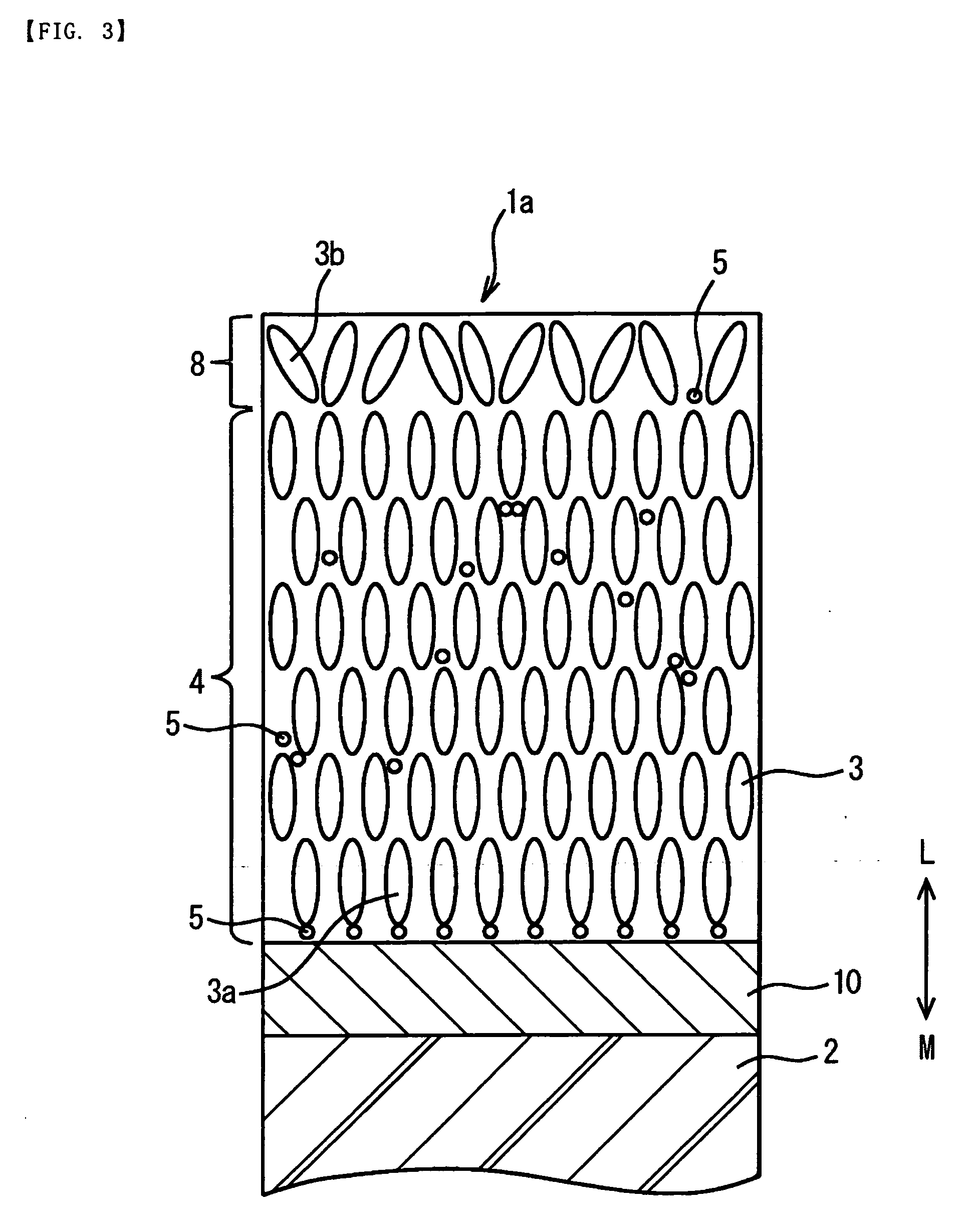Optical element obtained by homeotropically orienting liquid crystal molecule, member for liquid crystal display device using the same, and liquid crystal display device
a liquid crystal molecule and optical element technology, applied in the direction of optical elements, instruments, transportation and packaging, etc., can solve the problems of significant increase in production cost, limited number of liquid crystal display devices each capable of using liquid crystal film, and damage to orientation, so as to prevent any damage to orientation, reduce the thickness of the liquid crystal display device, and reduce the production cost of the optical element of the present invention
- Summary
- Abstract
- Description
- Claims
- Application Information
AI Technical Summary
Benefits of technology
Problems solved by technology
Method used
Image
Examples
example 1
[0193] The vertical alignment layer solution was patterned onto the upper surface of a glass base material by means of a flexographic printing method to form a film having a thickness of 600 Å. The resultant was baked at 180° C. for 1 hour, so a vertical alignment layer was formed on the glass base material. Next, the base material on which the vertical alignment layer had been formed was installed in a spin coater (trade name “1H-360S” manufactured by MIKASA), and the birefringence layer composition liquid prepared in advance was applied to the upper surface of the alignment layer by means of spin coating in such a manner that a thickness after drying would be about 1.5 μm. In this example, a spin coating method was adopted as a method of applying a liquid crystal solution. However, a method of applying a liquid crystal solution is not limited thereto. For example, die coating, slit coating, and an approach as a result of combination of them can be appropriately selected. The same ...
example 2
[0197] A base material 2 was formed in the same manner as in Example 1, and Example 2 was produced in the same manner as in Example 1 except that the surface of the base material 2 (surface opposite to the glass base material) was ground by means of a grinding attachment by 1,000 Å.
example 3
[0209] The liquid crystal display device shown in FIG. 9B was produced as a liquid crystal display device using the optical element of the present invention, and was defined as Example 3.
[0210] The optical element of the present invention was formed in the same manner as in Example 1 except that a coloring layer was formed between a glass base material washed through a pretreatment and a vertical alignment layer in order to produce Example 3.
[0211] To form the above coloring layer, at first, a photoresist for a BM prepared as described above was applied to the upper surface of the glass base material by means of a spin coating method to have a thickness of 1.2 μm, and the whole was pre-baked at 80° C. for 3 minutes. Then, the resultant was exposed to light (100 mJ / cm2) by means of a mask formed into a predetermined pattern. Subsequently, the resultant was subjected to spray development with a 0.05% aqueous solution of KOH for 50 seconds. After that, the resultant was post-baked at...
PUM
| Property | Measurement | Unit |
|---|---|---|
| specific gravity | aaaaa | aaaaa |
| thickness | aaaaa | aaaaa |
| thickness | aaaaa | aaaaa |
Abstract
Description
Claims
Application Information
 Login to View More
Login to View More - R&D
- Intellectual Property
- Life Sciences
- Materials
- Tech Scout
- Unparalleled Data Quality
- Higher Quality Content
- 60% Fewer Hallucinations
Browse by: Latest US Patents, China's latest patents, Technical Efficacy Thesaurus, Application Domain, Technology Topic, Popular Technical Reports.
© 2025 PatSnap. All rights reserved.Legal|Privacy policy|Modern Slavery Act Transparency Statement|Sitemap|About US| Contact US: help@patsnap.com



